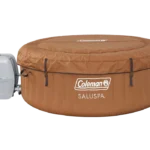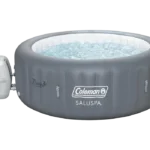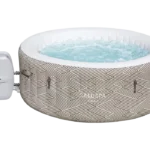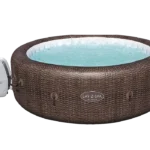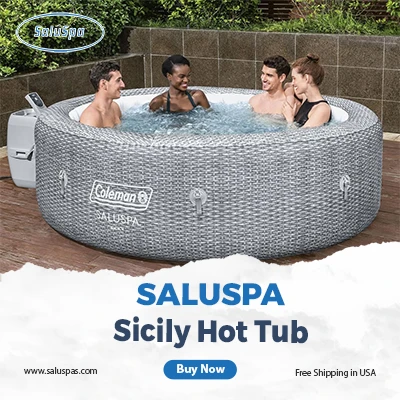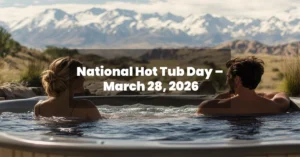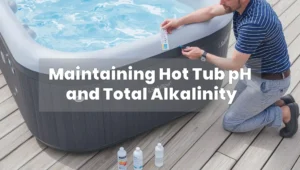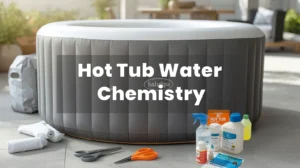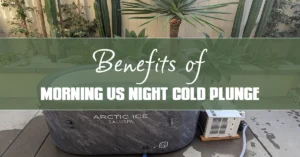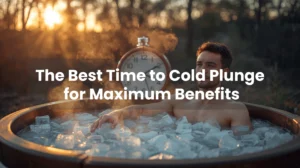If you have a hot tub, you know maintaining crystal clear, inviting water is not as simple as filling it and turning on the jets. Water chemistry is not only a visual thing, but the backbone of creating a safe, comfortable and pleasurable spa experience. Balanced chemicals make your skin safe, protect equipment for years from wear and tear and save you money.
With water chemistry, if something goes wrong you see it quickly. Perhaps you just finally see cloudy or unappealing water, feel skin irritation or red eyes following a soak, or notice scale build up on your spa shell and heating elements. Unbalanced water can slowly eat away at pumps, seals and eventually result in expensive repairs. The good news? Once you have a basic understanding of hot tub chemicals and routine, keeping your spa water properly balanced is second nature.
This guide will take you through all you need to know — from understanding basic parameters to troubleshooting common problems. Whether you’re a first time spa owner, or desire the latest in care and maintenance techniques for your existing asset, this clear how-to guide not only provides you with a routine maintenance schedule to properly care for its equipment: It goes on to offer expert advice on water balance range calculations and new sanitizing options.
Spa Water Chemistry Fundamentals
The chemical management of hot tubs isn’t the same as for pools. Increased load factors; greater bather-to-water ratios are issues made more acute by even relatively small temperatures (normally 100-104°F) and limited volume of water. Heat can speed chemical reactions, helping sanitizers work faster while also breaking down more rapidly. And its small volume means a higher concentration of impurities — body oils, lotions, sweat — have more of an effect.
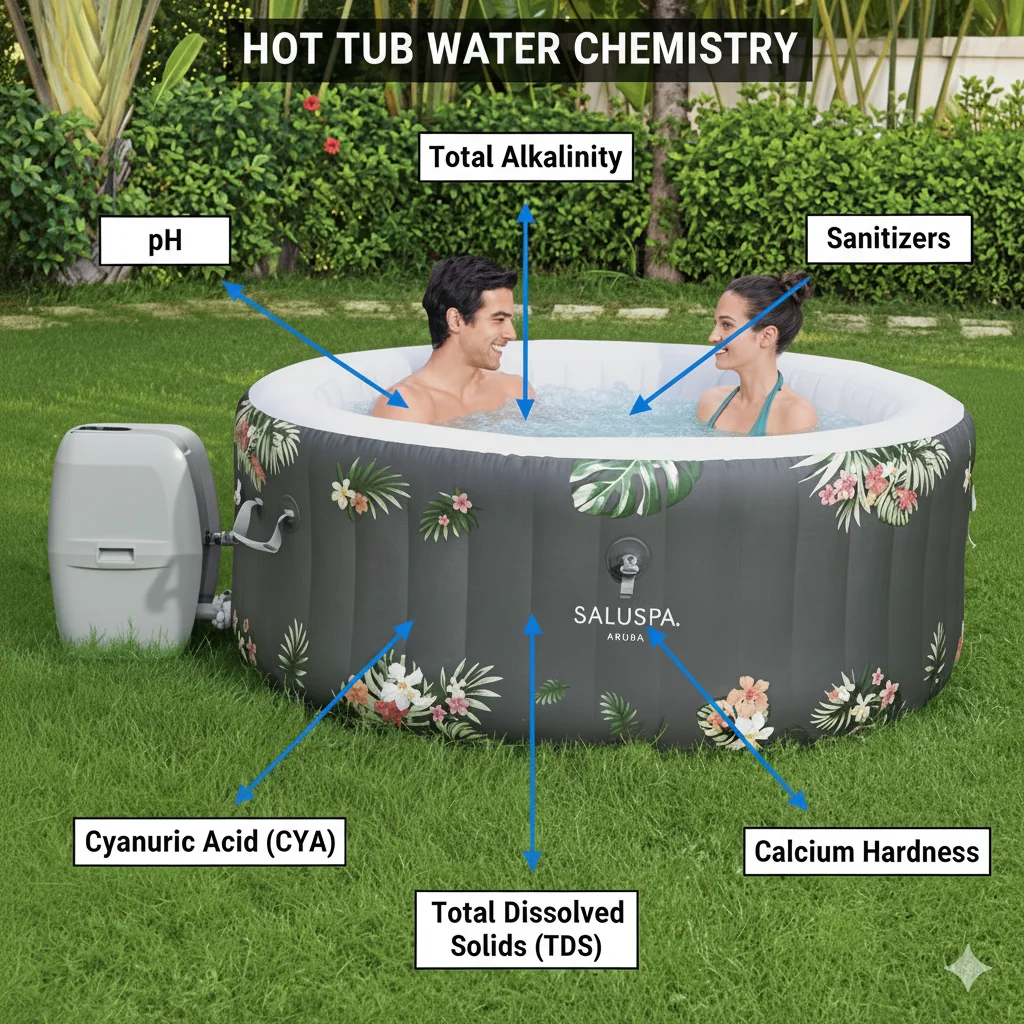
Consider your spa water a delicate ecosystem. While there are a lot of things to consider these smart water care products makes it easy for you as they work together so you only have to use a couple balancing your spa’s water and keeping it safe: pH (water’s acidity), Total Alkalinity (pH buffer), sanitizers which includes, bromine or chlorine, Calcium Hardness (soft-water vs. hard-water) & Total Dissolved Solids (stuff that doesn’t need to be in the water). it also sometimes contains Cyanuric Acid (chlorine stabilizer). When one variable moves, others frequently move with it, so it is important to know the links between them.
Well balanced water is an insurance policy for you and your investment. The right water chemistry prevents skin and eye irritation, keeps water sparkling clear as well as protecting your spa’s equipment. Heaters, pumps and jets are not cheap to replace and imbalanced water is one of their greatest foes. At the other end of the scale, pristine water allows you to use your spa whenever you want without any fear at all.
The Key Water Balance Parameters
pH (Acidity & Comfort)
pH indicates whether your water is acidic or alkaline, on a scale of 0 to 14, with 7 being neutral. For hot tubs, that ideal is 7.2 to 7.6 — slightly alkaline and similar to the pH of human tears, which accounts for why balanced water doesn’t sting your eyes.
Below a pH of 7.2 (acidic water), several issues arise. The water becomes aggressive, which erodes metal parts, heating elements and spa surfaces. Your sanitizer gets a little too aggressive, resulting in skin irritation and an overpowering stench of chemicals. On the other hand, if pH gets too high (above 7.8) scaling occurs with deposits of calcium building up in surfaces and equipment. Because sanitizers become less effective in high-pH water, so you’re not getting the disinfection you think you are, your chemical levels may look fine.”
Adjusting pH is straightforward. Lower pH with some pH decreaser (sodium bisulfate or dry acid). Add slowly, in a few small amounts at a time while the jets are on. To raise pH, use pH increaser(sodium carbonate/soda ash). Test 30 minutes after any chemicals have been added and make adjustments slowly — you can always add more; backing out an overcorrection is another story.
Total Alkalinity (TA) – The pH Buffer
Total Alkalinity indicates the water’s capacity to resist pH changes – acting as a buffer against wildly fluctuating pH. The range 80-120 is the ideal, and most spas are best at 100 ppm.
This is why TA is important: Correct TA serves as a pH stabilizer, countering acid or base additions and the introduction of contaminants by pool users. Low TA (less than 80 ppm) results in “pH bounce” where you can’t seem to get a consistent pH reading, so it becomes impossible to keep the pool water balanced. High TA (over 120 ppm) will lock pH in and frequently too high for it not to budge.
The connection between TA and pH is essential. You should always adjust Total Alkalinity before you address pH. To raise your TA, alkalinity increaser (sodium bicarbonate – yes, baking soda, but spa products dissolve better). To reduce TA, same thing as PH but different method (Jets OFF, add the pH decreaser to pool and wait one hour, then turn jets ON and aerate the water). This decreases TA, but also reduces pH.
Calcium Hardness (CH)
Calcium Hardness is the amount of disolved calcium in your water, and it’s all about finding that perfect balance. The accepted range with hot tubs is 150 to 250 ppm — enough protection from corrosion, but not so much as it leads to scaling.
Water likes to be in balance. When the level of calcium drops too low (below 150 ppm) the water becomes “hungry” and will take what it can from your spa shell, plumbing, and equipment. You will see pitting, etching and equipment that dies too young. Too much calcium (above 250 ppm) causes cloudy water and white chalky scale on surfaces, jets and inside heaters which will cause them to work harder or even require expensive descaling.
Raising calcium is a cinch, and takes just adding calcium hardness increaser (calcium chloride), following the product packaging. It is also harder to lower it, because you can’t chemically take dissolved calcium away. #Your solutions are dilution (partial drain and refill of water) or using a sequestering agent to keep the calcium in suspension, but it’s only temporary. If you have unusually hard source water, consider a pre-filter when filling your hot tub.
Total Dissolved Solids (TDS)
TDS is everything that is dissolved in your water — the minerals found as part of the source water and built up over time, plus any chemicals, body oils, lotions and organic stuff. It’s a bit like water “aging.” New spa water could read 500 ppm, and every time chemicals are added or your tub is used you contribute to this total.
The general rule: once TDS is 1,500 ppm above your starting water’s TDS, it’s time to drain and refill. High TDS has a whole host of problems—water feels dead or heavy, your sanitizer stops working as well, you can’t get clear water no matter what happens and you may see foaming or smell odors.
TDS however you can’t eliminate except by dilution. No chemical fixes this. Testing each month allows you to know when it’s time to drain. If you have a high usage spa, the TDS limit can be reached in about 8 to 10 weeks. If you use it lightly, for 4-5 months (at most). That’s why there’s the old rule of thumb: drain and refill your hot tub every 3-4 months, or use this formula: Gallons ÷ Daily Bathers ÷ 3 = Days between draining.
Cyanuric Acid (CYA / Stabilizer)
Cyanuric Acid, or stabilizer and conditioner, is what protects your chlorine from being eaten up by the sun. It is necessary in outdoor pools but contentious in hot tubs. If you use chlorine in an outdoor spa then CYA at 30 to 50 ppm makes sense. And above this, well, you’re in trouble.
The trouble with CYA in hot tubs is that it presents too much of a barrier for the chlorine. Chlorine is lazy with high CYA (above 50ppm) — test shows chlorine present, but it’s not doing its job of sanitizing. This is called “chlorine lock.” Many spa owners are CYA-averse: They use stabilized chlorine, such as dichlor for regular doses, then switch to bleach; or they switch to bromine, which does not need stabilization.
When CYA gets too high, dilution is the only cure — drain some water off and top up. Dichlor chlorine adds both chlorine and CYA each time it is added, so the more you add, the more levels rise. Now you’re ready to swim like a pro, without worrying about getting itchy eyes once CYA levels get out of control.
Sanitizers & Oxidizers
Chlorine in Hot Tubs
Chlorine continues to be the favorite spa sanitizer, killing bacteria and algae effectively. Keep free chlorine at 3-5 ppm for sanitation. Chlorine works more rapidly in hot water, and dissipates faster, too, so regular testing is important.
The pros: chlorine works quickly, it’s easy to find and inexpensive, and most people already know how to use it. The cons: It smells of pools (actually chloramines, not pure chlorine), can be irritating to the skin and hard on swimsuits at high concentrations, and you’ll need to add it more often if your hot tub is hot, depending on how many people are using it.
For hot tubs the answer is dichlor (granular chlorine) for its fast dissolving properties and neutral pH. Stay away from trichlor tablets — they are highly acidic and slow to dissolve. A few others are pouring household bleach (sodium hypochlorite) into the pool as a low cost substitute for CYA once established. Check the chlorine level prior to use and dose if necessary after each hour of pool usage to ensure consistent levels.
See our Detailed Guide on: How Many Chlorine Tablets in SaluSpa? Recommended Dosage
Bromine in Hot Tubs
Bromine is an answer that many spa owners prefer, still using the 3 to 5 ppm range. Bromine is stable and designed for higher temperatures which makes it a good choice for hot tubs. It gives off a softer, less chemical odor and is far friendlier to skin and eyes.
The tradeoffs: Bromine costs more than chlorine, dissolves more slowly, and requires a floater or automatic feeder for consistent delivery. However, bromine has a unique advantage—when you shock the spa, bromamines (spent bromine) reactivate back into active bromine, giving you more bang for your buck over time.
Chlorine vs Bromine – Which To Use Deciding between chlorine and bromine is generally a personal preference. If you find the smell of chlorine irritating or if you have skin that is easily affected by chemicals, try bromine instead. And if you prefer speedy sterilization and a cheaper option, chlorine is the way to go. Some systems utilize the “bromine bank”–start with a residual of bromine, then shock it/hit it with chlorine (for advantages of both).
See our Detailed Guide on: How Many Bromine Tablets for SaluSpa? Complete Dosage & Maintenance Guide
Treatments The Terror of Shock (Chlorine Vs No-Chlorine Shock)
Shock isn’t about daily sanitation — it’s infrequent radical oxygenation therapy for your water. Shock treatments destroy chloramines (used, spent chlorine that smells and can create eye or skin irritation), bromamines, body oils and other unwanted organic contaminants that make water cloudy or smelly.
Chlorine shock (usually cal-hypo or concentrated dichlor) does both oxidation and a sanitizer boost. A hot tub cleaner should be used weekly, or when there are heavy bather loads. The downside: you have to wait three or so hours until you can use the spa until chlorine levels fall back through a safe range.
Non-chlorine shock, or potassium monopersulfate (MPS), is used for oxidizing impurities without increasing the level of chlorine or bromine. It’s effective in 15 minutes, so you can shock and soak with little waiting. The catch: it does not sanitize; rather, it oxidizes, so you still need sufficient sanitizer levels. Most spa owners use MPS for routine shocking, while using chlorine shock only when heavy oxidation is required.
Stun your spa at least weekly, and/or after parties or heavy use, when the water appears dull or smells funny, or whenever combined chlorine (total minus free) is above 0.5 ppm.
Other Types of Sanitizers (Ozone, UV, Salt Systems)
These systems cut, but don’t eliminate, a need for chemicals — they’re add-ons rather than substitutes. O₃ gas is then produced by a ozone generator, which oxidizes and sterilizes contaminants. They function around the clock, cutting sanitizer requirements by 25-50 percent but delivering no residual protection. You still need chlorine or bromine, but less of it.
UV sanitizing systems kill microorganisms inside a chamber as water passes through, using ultraviolet light. UV, like ozone does not leave any residuals for sanitation. Water that sits stagnant in jets and plumbing is unprotected, so it is still important to maintain 1-2 ppm chlorine or bromine.
Salt systems (the technical term is saltwater chlorine generators) convert dissolved salt into chlorine automatically. You keep about 1,750-2,500 ppm salt, and the cell generates chlorine as needed. Benefits are softer feeling water that also has less chlorine content to handle with fewer chemicals needed over time. Negatives are the initial expense, and it may cause corrosion of some metals with cell cleaning every 3-4 months.
Testing & Monitoring Spa Water
Types of Testing Kits
The spa test strips are easy to use: you dip them, wait 15 seconds and then compare colors. These test several parameters at once (PH, TA, hardness Sanitizer) and cost pennies per test. The downside: color matching is subjective, accuracy suffers in bright or low light and they’re less precise for critical parameters like sanitizer levels.
Liquid reagent kits (drop tests) provide better accuracy for chlorine bisulfite, certainly for chlorine/bromine. You drop it in a water sample and count however your stomach counter, changes color. Taylor and LaMotte manufacture professional-quality kits for pool services. The first type is more expensive up front but provides repeatable, consistent results. They’re an investment for people who are serious about water quality.
Types of digital testers vary from simple meters (pH/ORP pens) to the more complex photometers that measure several parameterselectrically. Higher-end models such as the LaMotte Spin Touch will remove human error from color reading. They’re overkill for most home spa owners; if you have trouble with color vision, or you want lab-grade accuracy, they’re here.
How Often Should You Test?
Frequency of testing will depend on use but here’s a good regimen:
Before every use (or daily for heavy user) : Check sanitizer level and pH. These change most quickly, and have the greatest impact on your comfort and safety.
Weekly: Test TA and Cal Hard. Shock therapy usually takes place once a week, so it’s a convenient time for intensive testing.
Monthly: Test TDS with an electronic meter if you have one. Test for metals (iron, copper) if you’re worried about source water.
Every 3-4 months: Testing the full panel when draining and re-filling. This is your reference point for the new water fill.
Make this schedule work for the way you use powders. High-traffic spas require more frequent testing; a monthly-used vacation property can test less frequently.
Maintenance Schedule (Daily, Weekly, Monthly)
Spa care is more about consistency than intensity. It can save hours of troubleshooting later to spend a few minutes daily on this. Here’s a realistic maintenance routine:
Daily Tasks (2-3 minutes):
- Test sanitizer level – keep between 3-5 ppm chlorine or bromine
- pH—Check quickly-an over range and you need a pH test/a Under 7.2 and an Ammonia Ca level of 0? You’re chasing your own tail thinking product can get both very low or high, that is not going to happen.
- Check water clarity ( finesse filter for dams) and remove any debris that can be seen.
- Run jets for short time if spa is not used daily
Weekly Tasks (15-20 minutes):
- Shock treatment (chlorine or MPS)
- TA test, calcium hardness and sanitizer
- Clean waterline with spa-safe cleaner
- Soak/Scrub filter Cartridge (if you have extras rotate out some spares)
- Check water level and adjust if necessary
Monthly Tasks (30-45 minutes):
- Chemically clean the deep filter. (degrease)
- Test TDS levels
- Examine for scale, deposits, or biofilm
- Inspect equipment compartment for any signs of leaks or moisture
- Add metal sequestrant if needed
Quarterly Tasks (half day):
- Drain and refill spa completely
- On clean plumbing lines with line cleaner
- Thoroughly clean and sanitize shell
- Deep clean or replace filter
- Rebalance water chemistry from scratch
- Proper hot tub water is an important sign of a clean and safe spa
Troubleshooting Common Hot Tub Water Issues
Cloudy Water
Murky spa water is just no fun. Common causes are low sanitizer (bacteria and organics multiply), dirty or worn out filters (which don’t filter well), a high TDS level (water is over-saturated with dissolved solids ), improper pH/TA balance so minerals precipitate, or dead algae after you shocked.
Solutions: Testing sanitizer and run boost to 5-10 ppm if low. Take the filters out and clean or replace them — they may seem like they’re clean, but often there are oil clogs in them. You can use filter cleaner soak if required. Oxidise organics with a dose of chlorine or MPS. Test and balance pH and TA. If problems persist after balancing and shocking, test the water for TDS; levels in excess of 2,000 ppm frequently signal that it’s time to drain.
Foamy Water
Foam is produced when the surface tension of water is altered, which typically consists of body oils, lotions and soaps or low calcium hardness. Proactive Foam: If there’s heavy algae growth on your water source, a visible scum forms.
Fixes: Request users to shower first and steer clear of lotions or oils. Treat it with an enzyme product or a foam-down chemical for quick relief, but these are Band-Aids. Test for calcium hardness—low levels (below 150 ppm) can result in foaming. Add more of the hardness increaser to maintain it between 175-200 ppm. For chronic problems, drain and refill — sometimes old water is simply full of organics that can’t be flushed.
Scale Buildup
White, chalky stains on your spa shell, jets or heater is scaling from high calcium hardness and/or high pH. Scale insulates heating elements (increasing your energy bill), clogs jets and is unattractive/disgusting.
Solutions: Test and adjust pH to 7.2-7.4 range with a pH decreaser. Check calcium hardness: if it is more than 250 ppm, schedule a partial drain/refill to lower it. Use a scale remover product as directed on the label. We suggest adding a sequestering agent monthly to help stop scaling. If your source water’s very hard, a pre-filter during filling is worthwhile.
Strong Chlorine Smell
The strong odor is ironic, because that actually means you are low on available free chlorine — instead, it’s turned into combined chlorines, which are spent chlorine molecules bound to contaminants. The chlorine in a typical city water supply is not exactly refreshing, but chloramines (combinations of chlorine and ammonia) can irritate eyes and skin and stink.
Fix: Super-chlorinate the hot tub at a 5-10 ppm level, or as directed on your shock product label. Run jets for 15-30 minutes with cover open to facilitate off-gassing of chloramines. After shocking, be sure to keep free chlorine at the correct level (3-5 ppm). If the smell comes back soon you may be under sanitizer, test more often and even consider drain/refill if TDS is high. For a fresher soaking experience, you can also explore hot tub aromatherapy products to enhance the scent and relaxation.
Skin & Eye Irritation
There are a few culprits of discomfort that can range from low pH (under 7.0) which creates acidity making it feel like you are swimming in lemons, high pH (above 7.8) that lets chloramines form backing the swimmer into a gaseous corner or perhaps there is insufficient sanitizer allowing the bacteria to thrive…or worse yet – combined chlorine has developed which produces some compounds that will irritate the skin and stype!
Solution: Test and balance pH to 7.4-7.6. Test chlorine—if total chlorine exceeds free chlorine by 0.5 ppm or more, you have combined chlorine. A shock treatment will break the bonds and restore free chlorine. maintain adequate free chlorine. replenish stabilizer if TA is in range but continue to experience pH drift. If problems persist after balancing, consider switching from chlorine to bromine or investigate alternative sanitizer systems.
Safety Tips for Handling Spa Chemicals: Spa chemicals are powerful, and their handling requires great caution. Keep them somewhere cool, dry, and out of the sun. Keep them separated from one another and well clear of children and pets. Moisture causes chemical reactions, so keep all containers sealed. Spa chemical reacts violently with one another toasting immediately with contact when people breathing them.
Wear safety goggles and gloves when dealing with concentrated chemicals. For repairs, work in a properly ventilated environment and avoid breathing in dust or fumes. Simply apply recommended steps on the product and read the instructions properly wait 30 min before test water again after added.apk on the water surface with jets on hand attendance for dispersion..
If: Your spa gets heavy use, you have trouble maintaining clear water, TDS is well above 1,500 ppm over source water level or the treating product is not effectively controlling odor and foaming — don’t make the potential problem worse by postponing a drain. If the pH or total alkalinity has been adjusted outside of the proper range and can’t be returned into range without making unnatural adjustments; Water condition is in line with these recommendations; Or every four months regardless of condition..
Drain/Refill Process:
- Kill power at circuit breaker for safety
- Connect drain hose to drain valve, or collect manually with a submersible pump
- Pour in plumbing line cleaner while draining (before water is completely drained) then run jets to flush biofilm out of lines
- After shell is emptied, clean Shell Drain & Spa with spa safe cleaner
- Clean or replace filter cartridge
- Top up with fresh water (use pre-filter if source water is hard or for metals)
- Once full, turn power back on
- test and balance new water (TA first, then pH, then hardness, then sanitizer)
- Shock before first use
Get Deatailed Insights on: How to Drain Your SaluSpa- A Comprehensive Guide
Final Thoughts
Once you have an understanding of the relationship between pH, alkalinity, sanitizers and hardness, mastering hot tub water chemistry is easy. Test often, incrementally adjust, and be consistent. Your payoff is crystal-clear, easy-on-the-skin water for a soft-water experience, and protection from any corrosion dulling your edge.
Or as I like to say, balance first, troubleshoot second. The majority of water problems can be traced back to pH, TA or sanitizer levels being out of whack. Correct those first before you throw your money at specialty products. Keep careful track of your test results and adjustments — patterns emerge that enable you to anticipate needs.
Your hot tub is an investment in relaxation and wellness. 15 minutes of weekly upkeep can spare many hours of aggravation and a hefty repair bill. Now that we have the know-how from this guide, you are prepared to keep your spa up all year long.
